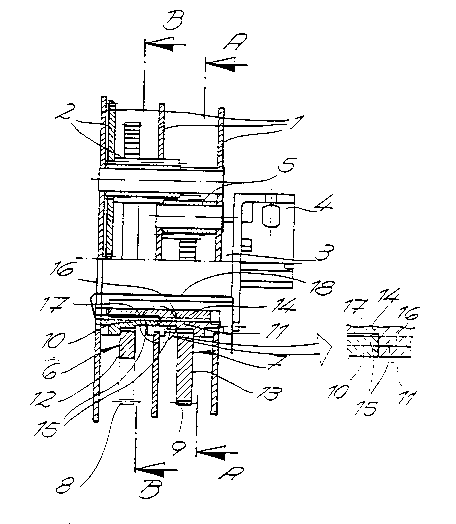Some of the information on this Web page has been provided by external sources. The Government of Canada is not responsible for the accuracy, reliability or currency of the information supplied by external sources. Users wishing to rely upon this information should consult directly with the source of the information. Content provided by external sources is not subject to official languages, privacy and accessibility requirements.
Any discrepancies in the text and image of the Claims and Abstract are due to differing posting times. Text of the Claims and Abstract are posted:
| (12) Patent Application: | (11) CA 2155469 |
|---|---|
| (54) English Title: | TRANSMISSION FOR AN ACTUATING DRIVE HAVING A SPRING RETURN FEATURE |
| (54) French Title: | TRANSMISSION POUR MECANISME D'ENTRAINEMENT A RAPPEL PAR RESSORT |
| Status: | Deemed Abandoned and Beyond the Period of Reinstatement - Pending Response to Notice of Disregarded Communication |
| (51) International Patent Classification (IPC): |
|
|---|---|
| (72) Inventors : |
|
| (73) Owners : |
|
| (71) Applicants : | |
| (74) Agent: | AVENTUM IP LAW LLP |
| (74) Associate agent: | |
| (45) Issued: | |
| (22) Filed Date: | 1995-08-04 |
| (41) Open to Public Inspection: | 1996-02-18 |
| Examination requested: | 2002-07-31 |
| Availability of licence: | N/A |
| Dedicated to the Public: | N/A |
| (25) Language of filing: | English |
| Patent Cooperation Treaty (PCT): | No |
|---|
| (30) Application Priority Data: | ||||||
|---|---|---|---|---|---|---|
|
The invention relates to a transmission for a
spring return actuator The transmission comprises a
drive pinion (2) associated with the actuator, an
intermediate pinion (5) meshing with the drive pinion
(2), an output shaft (3) with a clutch (4) for a final
control element, and two wheels (6, 7) disposed on the
same spindle. The wheels (6, 7) have respective
external toothing (8, 9) and a respective rotatably
mounted hub (10, 11) which extends with the
interposition of an annular gap around the output shaft
(3). The drive pinion (2) is in engagement with the
external toothing (8) of one of the two wheels. The
intermediate pinion (5) engages in the external
toothing (9) of the other wheel. A clutch sleeve (14)
is disposed in the annular gap between the output shaft
(3) and the wheels (6, 7), is releasably connected to
the output shaft (3) and is in positive engagement with
the hub (10, 11) of one of the wheels (6 or 7). The
directlon of rotation of the output shaft (3) can be
changed by changing the clutch sleeve (14). - Fig. 1.
Note: Claims are shown in the official language in which they were submitted.
Note: Descriptions are shown in the official language in which they were submitted.

2024-08-01:As part of the Next Generation Patents (NGP) transition, the Canadian Patents Database (CPD) now contains a more detailed Event History, which replicates the Event Log of our new back-office solution.
Please note that "Inactive:" events refers to events no longer in use in our new back-office solution.
For a clearer understanding of the status of the application/patent presented on this page, the site Disclaimer , as well as the definitions for Patent , Event History , Maintenance Fee and Payment History should be consulted.
| Description | Date |
|---|---|
| Inactive: Adhoc Request Documented | 2018-06-06 |
| Revocation of Agent Requirements Determined Compliant | 2018-05-18 |
| Appointment of Agent Requirements Determined Compliant | 2018-05-18 |
| Inactive: IPC from MCD | 2006-03-11 |
| Inactive: IPC from MCD | 2006-03-11 |
| Inactive: IPC from MCD | 2006-03-11 |
| Time Limit for Reversal Expired | 2004-08-04 |
| Application Not Reinstated by Deadline | 2004-08-04 |
| Inactive: Agents merged | 2003-12-09 |
| Deemed Abandoned - Failure to Respond to Maintenance Fee Notice | 2003-08-04 |
| Inactive: Status info is complete as of Log entry date | 2002-08-19 |
| Letter Sent | 2002-08-19 |
| Inactive: Application prosecuted on TS as of Log entry date | 2002-08-19 |
| All Requirements for Examination Determined Compliant | 2002-07-31 |
| Request for Examination Requirements Determined Compliant | 2002-07-31 |
| Application Published (Open to Public Inspection) | 1996-02-18 |
| Abandonment Date | Reason | Reinstatement Date |
|---|---|---|
| 2003-08-04 |
The last payment was received on 2002-07-31
Note : If the full payment has not been received on or before the date indicated, a further fee may be required which may be one of the following
Please refer to the CIPO Patent Fees web page to see all current fee amounts.
| Fee Type | Anniversary Year | Due Date | Paid Date |
|---|---|---|---|
| MF (application, 2nd anniv.) - standard | 02 | 1997-08-04 | 1997-07-18 |
| MF (application, 3rd anniv.) - standard | 03 | 1998-08-04 | 1998-07-20 |
| MF (application, 4th anniv.) - standard | 04 | 1999-08-04 | 1999-08-04 |
| MF (application, 5th anniv.) - standard | 05 | 2000-08-04 | 2000-08-02 |
| MF (application, 6th anniv.) - standard | 06 | 2001-08-06 | 2001-08-07 |
| MF (application, 7th anniv.) - standard | 07 | 2002-08-05 | 2002-07-31 |
| Request for examination - standard | 2002-07-31 |
Note: Records showing the ownership history in alphabetical order.
| Current Owners on Record |
|---|
| WERNER BIRCHMEIER |
| Past Owners on Record |
|---|
| None |